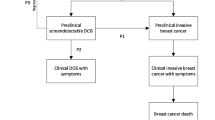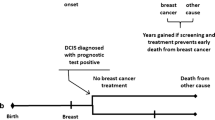Abstract
Background
Approximately 1% of patients with ductal carcinoma in situ (DCIS) will die of breast cancer within 10 years. Women who develop an invasive breast cancer after DCIS have a much greater risk of dying than those who do not and it is often stated that these deaths are a consequence of metastases from the invasive in-breast recurrence. This progression is the result of a two-step process: first local invasive recurrence and then spread beyond the breast. A large proportion of women who die of DCIS have no record of invasive recurrence. We used SEER data and a simulation approach to test whether the actual mortality data are consistent with the two-step model.
Methods
First, we constructed Kaplan–Meier mortality curves for all patients with pure DCIS and with small node-negative invasive breast cancers in the Surveillance, Epidemiology and End Results (SEER) registries database (1998–2014). We then constructed, through simulation, theoretical breast cancer mortality curves. To model the two-step scenario, we applied the annual incidence rates of incident invasive cancer following DCIS and of death from invasive cancer after DCIS to a theoretical cohort of 100,000 women.
Results
The observed 15-year breast cancer-specific mortality rate for patients with pure DCIS in the SEER database was 2.0%. The expected mortality for DCIS patients (assuming a two-step process) was only 1.1% at 15 years. Assuming the mortality rates following DCIS were one-half of those observed for patients with small invasive breast cancers, the expected mortality at 15 years post-DCIS was 2.1%.
Conclusions
In the SEER database, we observed far more deaths from DCIS than would be expected under a model where all deaths from breast cancer occur amongst women who experience an invasive local recurrence. This lends support to the hypothesis that DCIS mortality is not restricted to those women who experience an in-breast invasive cancer and that DCIS has properties similar to small invasive breast cancers.





Similar content being viewed by others
References
Lakhani SR, Ellis IO, Schnitt SJ, Tan PH, van de Vijver MJ (2012) WHO classification of tumours of the breast. IARC, Lyon
Burstein HJ, Polyak K, Wong JS, Lester SC, Kaelin CM (2004) Ductal carcinoma in situ of the breast. N Engl J Med 350:1430–1441
Narod SA, Sopik V (2018) Is invasion a necessary step for metastases in breast cancer? Breast Cancer Res Treat. https://doi.org/10.1007/s10549-017-4644-3
Sanger N, Engels K, Graf A et al (2014) Molecular markers as prognostic factors in DCIS and small invasive breast cancers. Geburtshilfe Frauenheilkd 74:1016–1022
Franken B, de Groot MR, Mastboom WJ et al (2012) Circulating tumor cells, disease recurrence and survival in newly diagnosed breast cancer. Breast Cancer Res 14:R133
Hüsemann Y, Geigl JB, Schubert F et al (2008) Systemic spread is an early step in breast cancer. Cancer Cell 13:58–68
Hosseini H, Obradović MM, Hoffmann M et al (2016) Early dissemination seeds metastasis in breast cancer. Nature. https://doi.org/10.1038/nature20785
Narod SA, Iqbal J, Giannakeas V, Sopik V, Sun P (2015) Breast cancer mortality after a diagnosis of ductal carcinoma in situ. JAMA Oncol 1:888–896
Elshof LE, Schmidt MK, Rutgers EJ, van Leeuwen FE, Wesseling J, Schaapveld M (2017) Cause-specific mortality in a population-based cohort of 9799 women treated for ductal carcinoma in situ. Ann Surg. https://doi.org/10.1097/SLA.0000000000002239
Wadsten C, Garmo H, Fredrikkson I, Sund M, Warnberg F (2017) Risk of death from breast cancer after treatment for ductal carcinoma in situ. Br J Surg. https://doi.org/10.1002/bjs.10589
Falk RS, Hofvind S, Skaane P, Haldorsen T (2011) Second events following ductal carcinoma in situ of the breast: a register-based cohort study. Breast Cancer Res Treat 129:929–938
Early Breast Cancer Trialists’ Collaborative Group (EBCTG), Correa C, McGale P et al (2010) Overview of the randomized trials of radiotherapy in ductal carcinoma in situ of the breast. J Natl Cancer Inst Monogr 41:162–169
Donker M, Litière S, Werutsky G et al (2013) Breast-conserving treatment with or without radiotherapy in ductal carcinoma in situ: 15-year recurrence rates and outcome after a recurrence, from the EORTC 10853 randomized phase III trial. J Clin Oncol 31:4054–4059
Sopik V, Sun P, Narod SA (2017) Impact of microinvasion on breast cancer mortality in women with ductal carcinoma in situ. Breast Cancer Res Treat. https://doi.org/10.1007/s10549-017-4572-2
Sopik V, Iqbal J, Sun P, Narod SA (2016) Impact of a prior diagnosis of DCIS on survival from invasive breast cancer. Breast Cancer Res Treat 158:385–393
Yen TW, Hunt KK, Ross MI et al (2005) Predictors of invasive breast cancer in patients with an initial diagnosis of ductal carcinoma in situ: a guide to selective use of sentinel lymph node biopsy in management of ductal carcinoma in situ. J Am Coll Surg 200:516–526
Yi M, Krishnamurthy S, Kuerer HM et al (2008) Role of primary tumor characteristics in predicting positive sentinel lymph nodes in patients with ductal carcinoma in situ or microinvasive breast cancer. Am J Surg 196:81–87
Zetterlund L, Stemme S, Arnrup H, de Boniface J (2014) Incidence of and risk factors for sentinel lymph node metastasis in patients with a postoperative diagnosis of ductal carcinoma in situ. Br J Surg 101:488–494
Sopik V, Narod SA (2017) DCIS and breast cancer: challenging the paradigm. Ann Surg. https://doi.org/10.1097/SLA.0000000000002417
Author information
Authors and Affiliations
Corresponding author
Ethics declarations
Conflict of interest
The authors declare that they have no conflicts of interest.
Rights and permissions
About this article
Cite this article
Giannakeas, V., Sopik, V. & Narod, S.A. A comparison of two models for breast cancer mortality for women with ductal carcinoma in situ: an SEER-based analysis. Breast Cancer Res Treat 169, 587–594 (2018). https://doi.org/10.1007/s10549-018-4716-z
Received:
Accepted:
Published:
Issue Date:
DOI: https://doi.org/10.1007/s10549-018-4716-z




